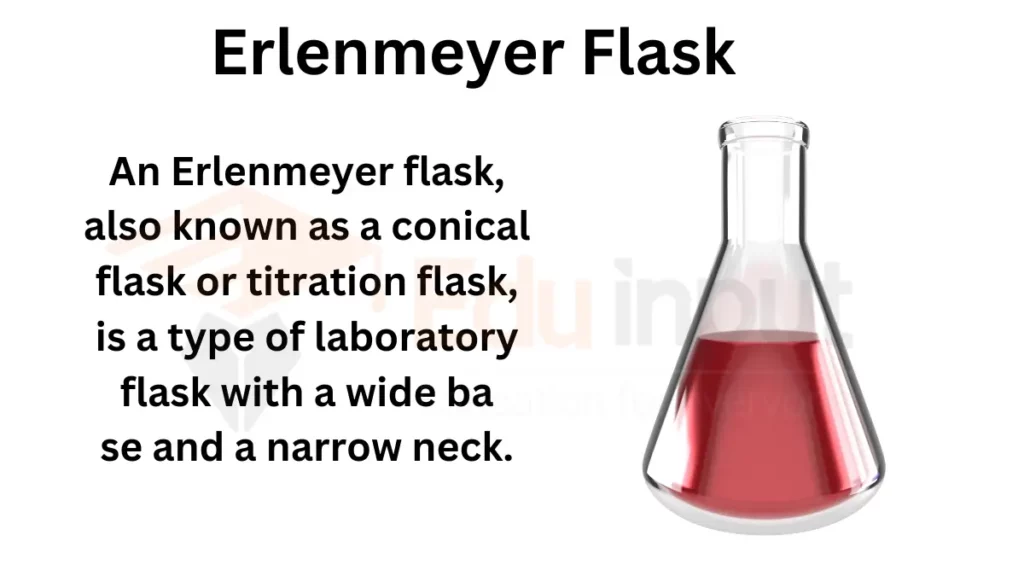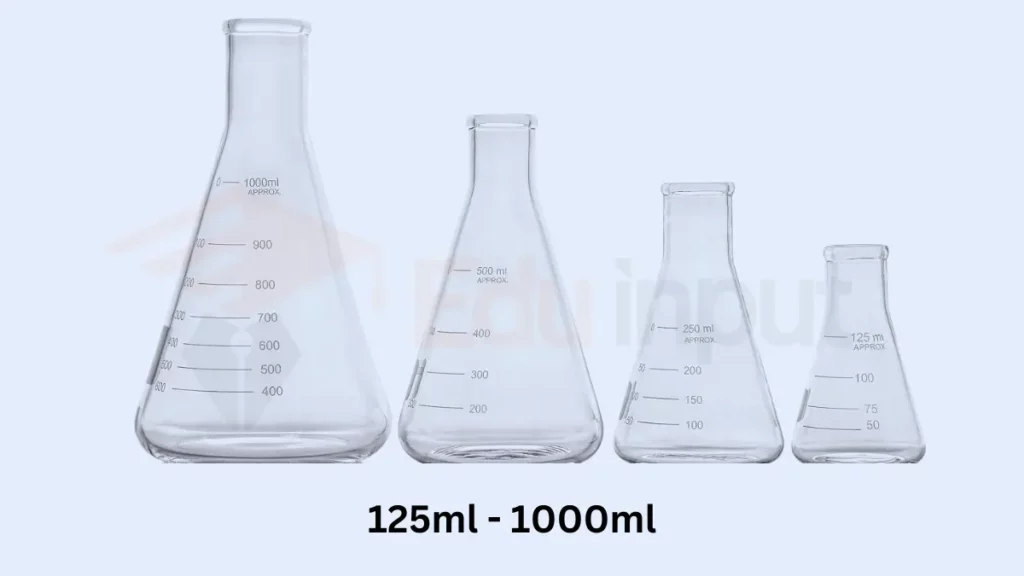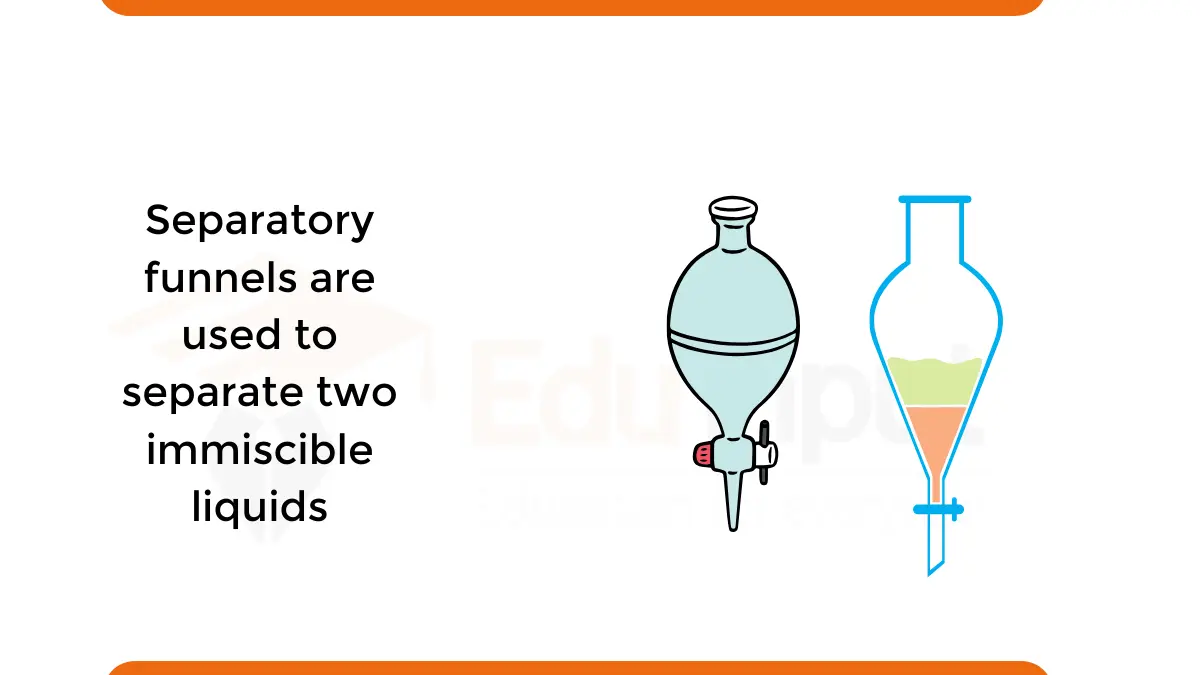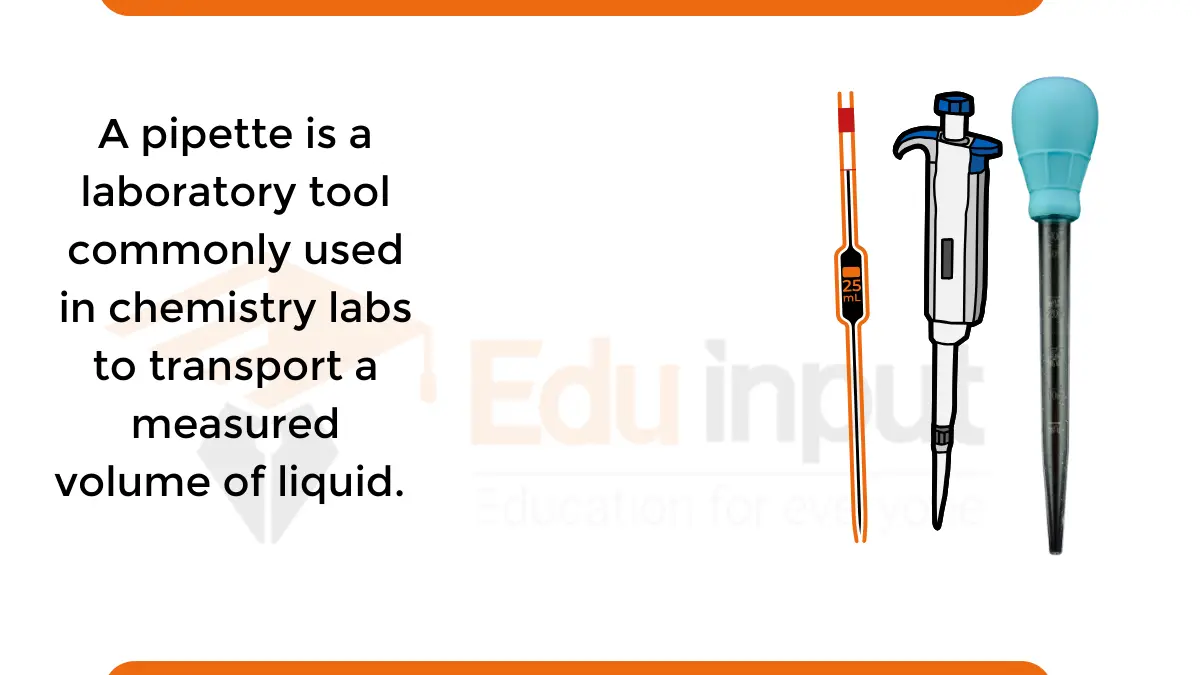Erlenmeyer Flask-Principle, Parts, Types, and Uses
An Erlenmeyer flask is a conical-shaped glass container that is commonly used in chemistry labs. It is one of the most Important Labortary apparatus. It has a wide base that provides stability, and a narrow neck that helps to prevent spills and evaporation.

Erlenmeyer flasks are versatile tools that can be used for a variety of purposes, including mixing chemicals, heating and cooling solutions, storing chemicals, conducting reactions, filtering solutions, and performing titrations.
Principle
The work of an Erlenmeyer flask, also known as a conical flask, is primarily based on the principle of fluid dynamics, particularly the flow of liquids due to gravity and concentration gradients. The conical shape of the flask plays a crucial role in facilitating efficient mixing, preventing spills, and enhancing the overall functionality of the flask.
Parts of Erlenmeyer flask
Here are the main parts of Erlenmeyer flask:
- Conical Body – The heart of the Erlenmeyer flask, the conical body tapers from a wide base to a narrow neck. This unique shape serves multiple purposes.
The wide base allows for efficient swirling of the liquid contents, promoting thorough mixing and agitating solutions without excessive splashing. The narrow neck effectively seals the flask, preventing spills during mixing or transport.
2. Flat Bottom – The flat bottom provides a stable platform for the flask, ensuring it remains upright during handling and operation. This stability is crucial for accurate mixing and controlled pouring.
3. Narrow Neck – The narrow neck serves several purposes, as it allows for precise addition of reagents or solutions, minimizing the risk of overshooting or spilling.
The narrow neck can be easily sealed with a stopper or cork, protecting the contents from evaporation or contamination.
4. Rim/Lip – The rim or lip of the flask is designed for controlled pouring. A plain rim allows for straightforward pouring, while a segmented rim provides additional stability and control.
Erlenmeyer Flask Sizes
Erlenmeyer flasks come in a wide range of sizes from 25mL to 5000 Ml.

- Small-Scale Experiments (25-125 mL) – Ideal for conducting precise titrations, preparing small reaction mixtures, and handling delicate reagents.
- General Mixing and Reactions (250-500 mL) – Commonly used for mixing solutions, conducting reactions, and storing intermediate products.
- Handling Large Volumes (1000-2000 mL) – Suitable for preparing larger reaction mixtures, storing solutions, and conducting experiments involving significant volumes of liquid.
- Industrial Applications (3000-5000 mL) – Utilized in industrial settings for large-scale reactions, batch preparation, and handling of bulk solutions.
Types of Erlenmeyer Flasks
In addition to the standard Erlenmeyer flask, several specialized types have been developed to meet specific laboratory requirements. These specialized flasks offer unique features that enhance their suitability for particular tasks.
1. Round-Bottom Flask
The round-bottom Erlenmeyer flask is also known as a boiling flask. It has a spherical body and a narrow neck. The round shape eliminates sharp corners, promoting more efficient mixing and reducing the risk of reagent interactions.

This flask is commonly used for recrystallization, distillation, and reactions that require gentle heating.
2. Static Flask
The static Erlenmeyer flask is designed to minimize static adsorption of charged solutions. Static adsorption occurs when charged molecules in a solution adhere to the surface of the container. This can affect the concentration of the solution and lead to inaccurate measurements.
Static flasks are typically made of low-adsorption materials, such as borosilicate glass or fluorinated polymers, to minimize static adsorption. They are commonly used for preparing and storing solutions of charged molecules, such as proteins and nucleic acids.
3. Vacuum Flask
The vacuum Erlenmeyer flask, also known as a Schlenk flask, features a side arm port for connecting a vacuum source. This allows for filtration and drying processes to be conducted directly in the flask without the need for an external filtration setup.

Vacuum flasks are commonly used for filtering solids from solutions, drying precipitates, and transferring air-sensitive materials.
4. Filter Flask
The filter Erlenmeyer flask is equipped with a perforated filter funnel that is fused to the neck of the flask. This allows for direct filtration of the liquid contents without the need for an external filter apparatus.
Filter flasks are commonly used for filtering solids from solutions under gravity or vacuum.
5. Volumetric Flask
The volumetric Erlenmeyer flask is a highly calibrated flask with a single, accurate volume marking. Volumetric flasks are used for precisely measuring and dispensing known volumes of liquids. They are commonly used in analytical chemistry and other applications where accurate volume measurements are critical.

How to use an Erlenmeyer Flask?
To ensure proper function and safety, follow these guidelines when using an Erlenmeyer flask:
- Always use a clean and dry flask to prevent contamination and maintain accuracy.
- Handle the flask with care to prevent breakage. Use a stable surface to avoid spills or tipping.
- Avoid vigorous shaking, which can cause breakage or excessive splashing. Gently swirl the contents to promote thorough mixing.
- Pour liquids through the lip in a controlled manner to prevent spills.
- Cover the neck with a stopper or foil when necessary to prevent evaporation or contamination.
Uses of Erlenmeyer flasks
Here are some of the most common uses of Erlenmeyer flasks:
- Mixing reagents – The conical shape of the flask allows for efficient mixing of liquids, making it ideal for preparing solutions for titrations, reactions, and other laboratory procedures.
- Heating and cooling – The flask’s wide base provides a stable platform for heating or cooling the contents. It can be heated directly over a Bunsen burner or placed in a water bath.
- Storing chemicals – Erlenmeyer flasks can be used to store liquids, solids, and gases. The narrow neck helps to prevent evaporation and contamination.
- Conducting reactions – The flask’s conical shape helps to prevent spills during reactions and allows for easy swirling to mix the contents.
- Filtration – Erlenmeyer flasks can be used for gravity filtration or vacuum filtration.
- Titration – Erlenmeyer flasks are commonly used for titrations, a type of analytical chemistry technique that measures the concentration of an unknown solution.
- Precipitation reactions – Erlenmeyer flasks are often used to conduct precipitation reactions, which involve the formation of solid particles from a solution.
- Crystallization – Erlenmeyer flasks are used to crystallize solids from solutions.
- Extracting solvents – Erlenmeyer flasks are used to extract solvents from solutions.
- Analyzing samples – Erlenmeyer flasks are used to analyze samples in a variety of laboratory techniques, such as spectroscopy and chromatography.
Also read:







Leave a Reply